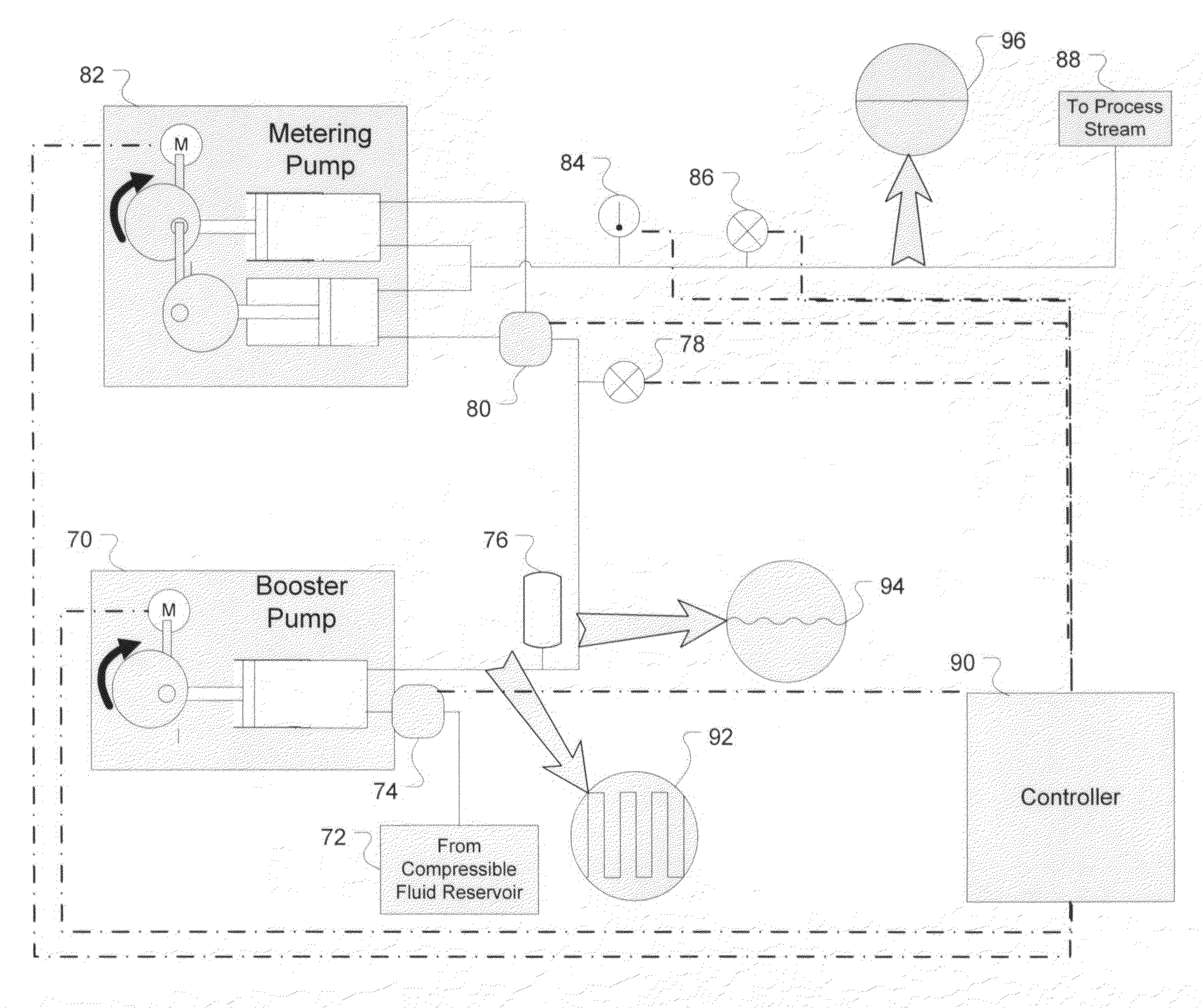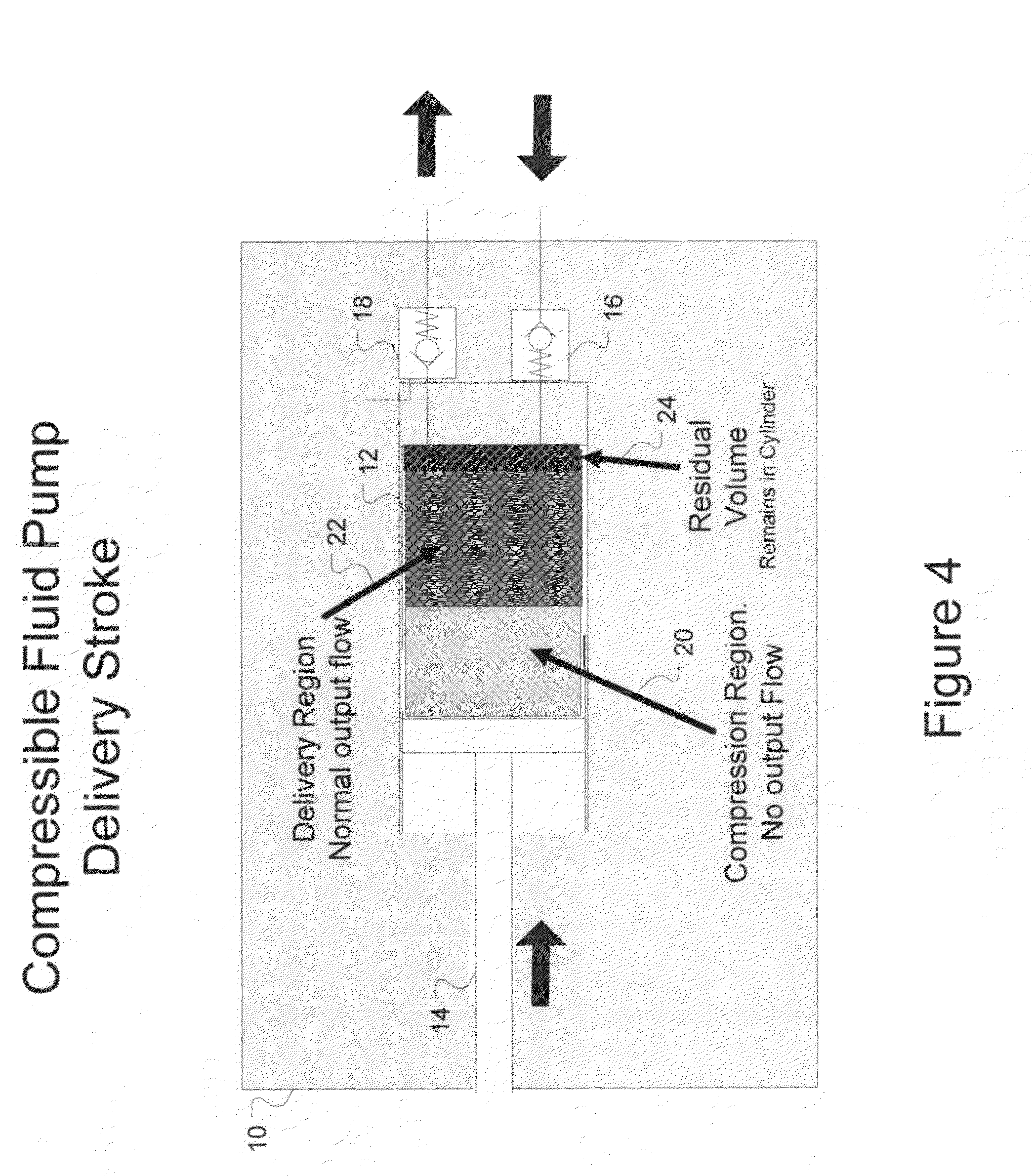Compressible fluid pumping system
a compression fluid and pumping system technology, applied in the direction of positive displacement liquid engine, separation process, instruments, etc., can solve the problems of variable leakage back to the low pressure side, magnetic coupling with lower torque limit, reciprocating pump can only emulate continuous rotary pump approximately, etc., to achieve low compressibility, low noise, and low cost
- Summary
- Abstract
- Description
- Claims
- Application Information
AI Technical Summary
Benefits of technology
Problems solved by technology
Method used
Image
Examples
first alternative embodiment
[0076]An alternative embodiment of the invention is displayed in FIG. 9. Booster pump 100 receives compressible fluid from reservoir 102. The fluid is chilled at prechiller 104 prior to entering the booster pump. On exit from the booster, the fluid passes optional pulse dampener 106 and the flow is then split between back pressure regulator (BPR) 108, which returns a portion of the flow to the low pressure side of the booster, and the flow path leading to metering pump 114. The later flow path also contains booster pressure sensor 110 and thermal conditioning device 112. The output flow stream of metering pump 114 leads to optional flow sensor 116, process pressure sensor 118 and finally to process stream 120. Controller 122 receives the signals of pressure sensors 110 and 118 and flow sensor 116. The controller also controls back pressure regulator 108 and prechiller 104. Optionally, the controller also controls the flow rate of booster pump 100 and / or metering pump 114.
[0077]In th...
second alternative embodiment
[0083]A second alternative embodiment of the invention illustrated in FIG. 10 demonstrates the extensibility the invention to a plurality of process streams. In this alternative embodiment, a single booster pump 124 supplies pressurized working fluid from compressible supply 152 to multiple metering pumps 126, 128, and 130 connected in series with the booster pump 124 and in parallel with each other. A pre-chiller installed between compressible fluid supply 152 and booster pump 124 to cool any incoming compressed gas to below its supply temperature and chill the booster pump head to prevent cavitation. Other flow devices including pulse dampener 132, booster pressure sensor 134 and thermal conditioning device 136 are positioned in the series line between the booster and all parallel metering pumps. Each metering pump supplies working fluid via a process pressure sensor 138, 140, or 142 respectively, to an individual process stream 144, 146, or 148 respectively. Not shown in FIG. 10 ...
third alternative embodiment
[0085]FIG. 11 displays a variation of the parallel processing stream concept from FIG. 10. In this case individual metering pumps 126-130 are replaced with a single drive, multi-output pump device 156. The implementation shown in FIG. 11 as metering pump 156 is a planetary gear pump mechanism which receives a single input and distributes flow evenly between multiple outputs. Alternatively, a pump that can also be considered is the radial piston pump comprised of multiple pairs of opposing pistons in a radial configuration. In this implementation opposing pistons are joined to the same process stream to deliver a pulseless output flow.
[0086]Addition of a single flow sensor 154 at the input to the metering pump 156 can indicate total flow that is then distributed evenly between the multiple processes. Pressure sensors 158-166 monitor pressure on each respective multiple outputs of metering pump 156 and provide pressure feedback to a controller of booster pump 124. Each multiple output...
PUM
| Property | Measurement | Unit |
|---|---|---|
| pressure | aaaaa | aaaaa |
| pressure | aaaaa | aaaaa |
| pressure | aaaaa | aaaaa |
Abstract
Description
Claims
Application Information
 Login to View More
Login to View More - R&D
- Intellectual Property
- Life Sciences
- Materials
- Tech Scout
- Unparalleled Data Quality
- Higher Quality Content
- 60% Fewer Hallucinations
Browse by: Latest US Patents, China's latest patents, Technical Efficacy Thesaurus, Application Domain, Technology Topic, Popular Technical Reports.
© 2025 PatSnap. All rights reserved.Legal|Privacy policy|Modern Slavery Act Transparency Statement|Sitemap|About US| Contact US: help@patsnap.com



